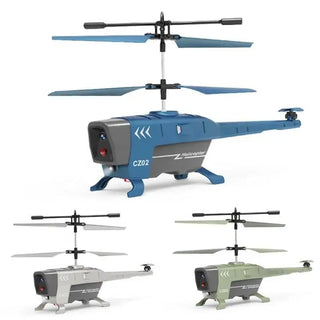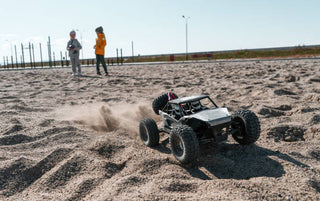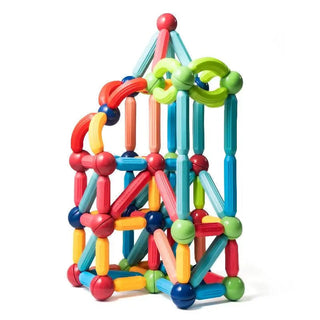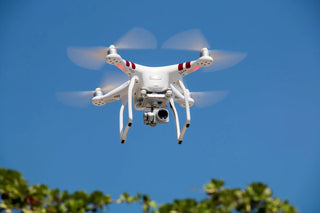It's a busy time for news drones, with a lot happening in how they're being used and what they can do. From the battlefield to commercial projects, these unmanned flying machines are changing things fast. We're seeing new ways they're armed, how countries are racing to get the best tech, and how smart computer programs are making them even more capable. Plus, regular companies are jumping in, and we're seeing new kinds of threats from drones that have been modified for fighting.
Key Takeaways
- The U.S. Army is now using small drones that can carry weapons, with the RQ-28A quadcopter being a notable example for delivering munitions.
- Global investment in drone technology has ramped up, especially due to the conflict in Ukraine, making it a key area for major world powers and European nations.
- Artificial intelligence is making drones smarter, allowing for more independent operation, better accuracy, and new uses in logistics and reconnaissance, with even talk of nuclear payload delivery.
- Commercial companies and startups are leading much of the innovation in drone tech, with venture capital funding new developments and helping to scale up production.
- The use of weaponized drones, including those with improvised explosive payloads, is a growing concern, as seen in conflicts like Syria and Afghanistan, changing how modern warfare is fought.
Advancements in Military Drone Capabilities
The U.S. Army is really getting into small armed drones, which is a pretty big deal. They've been testing these things out, and the idea is to give soldiers on the ground a way to hit targets that might be too risky for them to approach directly. It's like giving them a pair of eyes in the sky that can also pack a punch.
U.S. Army Fields Small Armed Drones
The Army recently made a bit of a splash with a video showing soldiers dropping live grenades from a drone. This was a first for them, using what they call the RQ-28A, a quadcopter made by Skydio. They're calling it a "force for the Sky Dragons" within the XVIII Airborne Corps. Soldiers are training with these systems at Fort Bragg, North Carolina, which is a major hub for Army operations. It sounds like they're serious about making these drones a standard part of how they fight.
Marine Corps Embraces Small Unmanned Systems
It's not just the Army, either. The Marine Corps is also really pushing to get small unmanned systems, including armed drones, into their ranks. They've been pretty open about wanting to integrate this technology to give their Marines more options and better situational awareness. It seems like the whole military is realizing how useful these smaller, more agile drones can be.
RQ-28A Quadcopter for Munitions Delivery
The specific drone getting a lot of attention is the RQ-28A. This quadcopter is designed to carry and drop munitions, like those grenades the Army tested. It's a pretty compact system, but it's meant to give infantry units a way to engage targets from a distance. Think of it as a portable, flying weapon system that can be deployed quickly. This kind of capability could really change how small units operate on the battlefield. It's a big step up from just having reconnaissance drones; now they can actively participate in combat operations.
The shift towards smaller, armed drones means that even basic infantry units can gain a significant advantage, providing direct fire support and reconnaissance capabilities that were previously unavailable or required calling in heavier assets. This decentralization of firepower is a notable change in military tactics.
Here's a quick look at what these drones offer:
- Payload Capacity: Capable of carrying small munitions like grenades.
- Mobility: Easily transportable and deployable by ground troops.
- Operational Range: Provides over-the-horizon targeting and engagement.
- Cost-Effectiveness: Generally less expensive to operate than larger aircraft.
This move towards equipping soldiers with these types of drones is part of a larger trend in how militaries are thinking about modern warfare. It's all about having the right tools for the job, and these small armed drones seem to be fitting that bill. The ability to get a remote-control airplane into the fight quickly and effectively is a game-changer. They're really trying to make sure their forces have the edge.
Global Drone Technology Race
The race to develop and deploy advanced drone technology is heating up, with nations worldwide pouring resources into this critical area. The ongoing conflict in Ukraine has significantly accelerated investment and innovation in unmanned systems. Both sides are constantly pushing the boundaries, seeking ways to make drones fly further and resist electronic jamming. This has led to a surge in new designs and tactics being tested in real-world combat scenarios.
Ukraine Conflict Accelerates Drone Investment
The battlefield in Ukraine has become a proving ground for drone technology. We're seeing rapid development driven by the urgent need for effective reconnaissance, surveillance, and strike capabilities. This conflict is forcing a reevaluation of drone strategies globally, as its impact on modern warfare becomes undeniable. Nations are recognizing that a robust drone program is no longer optional but a strategic necessity.
Strategic Importance for Major Powers
Major global powers view drone technology as a key component of future military strength. Control of the skies, even with unmanned systems, offers significant advantages. This includes intelligence gathering, force protection, and the ability to project power without risking pilots. The competition is fierce, with countries investing heavily in research and development to stay ahead.
European Countries Invest in Drone Tech
Across Europe, there's a growing commitment to bolstering domestic drone capabilities. Many European nations are looking to reduce reliance on foreign suppliers and develop their own advanced unmanned systems. This includes everything from small, tactical drones for infantry use to larger, more sophisticated platforms for surveillance and logistics. The goal is to build a resilient and capable drone industry that can meet evolving security challenges. For example, some countries are looking at specialized drones like the Sbego pocket drone for specific missions.
Artificial Intelligence and Drone Warfare

Artificial intelligence is really changing how drones are used in the military. It’s not just about flying anymore; AI is making these machines smarter and more capable. This shift means drones can do more complex jobs with less human input.
AI Enhances Drone Autonomy and Precision
AI is making drones much more independent. They can now figure out their own flight paths, identify targets without constant human guidance, and even make decisions in real-time during missions. This means they can operate more effectively in busy or dangerous airspace. Think about it: a drone that can spot a specific vehicle in a crowded area and track it without a person looking at a screen the whole time. That’s a big deal for reconnaissance and surveillance. The precision AI brings also means fewer mistakes and better mission outcomes. It’s like giving the drone a brain, allowing it to process information and act on it.
AI-Driven Logistics and Reconnaissance
Beyond just flying and fighting, AI is also being used to manage the support side of drone operations. This includes things like planning supply routes for drones, predicting maintenance needs, and even coordinating swarms of drones for large-scale tasks. For reconnaissance, AI can sift through vast amounts of data collected by drones – like video feeds or sensor readings – and pick out the important bits. This saves human analysts a ton of time and helps them focus on what really matters. It’s about making the whole drone system work more smoothly and efficiently.
Potential for Nuclear Payload Delivery
This is where things get really serious. AI-powered drones are being looked at for delivering nuclear payloads. Their ability to navigate complex defenses and strike targets with high accuracy makes them a potential tool for this kind of mission. The idea is that these drones could bypass traditional air defense systems, making nuclear delivery more reliable. However, this also brings up a lot of questions about control and escalation.
The integration of AI into drone systems, especially those with nuclear capabilities, raises significant concerns about unintended escalation and the potential for errors in judgment. Ensuring robust human oversight remains a critical challenge.
It’s a tricky area, and the implications for global security are huge. The speed at which AI can process information and make decisions could change how nuclear deterrence works, and not necessarily for the better. We’re talking about a future where machines might play a role in decisions that were once exclusively human, and that’s a big change.
Commercial Innovation in Drone Sector

The drone world is really buzzing with new ideas coming from outside the usual defense contractors. It’s mostly startups and venture capital money that are pushing things forward, operating pretty differently from the old-school military way of doing things. They’re all about quick changes and being able to adapt.
Startups Drive Unmanned Technologies
Smaller companies are the ones really shaking things up. They’re not bogged down by huge, old systems. This means they can try out new concepts and get them into the field much faster. It’s a different approach, focusing on what works now rather than what’s been planned for years. Think of it like building with Micro Particle Animal Building Blocks – you can create something new and different every time.
Venture Capital Fuels Drone Development
Money from investors is a big deal here. It allows these startups to grow, hire more people, and build more drones. Without this funding, a lot of these cool new ideas would just stay as ideas on paper. It’s this investment that helps turn a prototype into something you can actually buy and use.
Scaling Production of Mature Drone Tech
There’s a real need for the military to have a specific budget set aside just for buying drone tech that’s already proven and ready to go. Companies that can make a lot of drones quickly are the ones that need this support. It’s about getting proven technology into the hands of users without a lot of waiting around. The military should really be looking to these commercial makers for the stuff that’s almost ready for the battlefield, rather than trying to build everything themselves from scratch. This way, they can get what they need faster and in larger numbers.
The military needs to be smart about where it puts its money. Focusing on buying drone tech that’s already developed and can be produced in large quantities makes a lot of sense. It’s about getting the best tools available without reinventing the wheel every time.
Evolving Threats from Weaponized Drones
It’s pretty wild how fast things are changing with drones, especially when you think about how they’re being used in conflicts. We’ve seen this play out in places like Syria, where weaponized commercial drones, sometimes just carrying simple explosives meant to detonate on impact, have become a real problem. That same kind of threat has popped up in Afghanistan too. Honestly, it’s made military leaders admit that modern warfare has fundamentally shifted.
I remember reading about how a retired Army General, who’d been in the service for nearly four decades, said he never had to worry about looking up during his time in Iraq, Afghanistan, or Syria. That’s because the U.S. always had air superiority, keeping everyone safe. But now, with everything from tiny quadcopters to much larger unmanned aerial vehicles (UAVs), that luxury isn't guaranteed anymore. It’s a big change.
Syrian Conflict Highlights Drone Threats
In Syria, the use of weaponized drones, often modified commercial models, has become a significant concern. These systems, capable of carrying improvised explosive payloads, are designed for direct impact and detonation, causing damage and disruption. This has forced military forces to adapt their strategies and defenses.
Afghanistan Sees Improvised Explosive Payloads
The threat has migrated, and Afghanistan has also witnessed the deployment of drones carrying improvised explosive payloads. This trend underscores the adaptability of non-state actors and the evolving nature of asymmetric warfare, where readily available technology can be repurposed for destructive aims.
Shifting Character of Modern Warfare
These developments have led to a widespread acknowledgment within military circles that the character of modern warfare is changing. The ubiquity of drones, from small quadcopters to larger UAVs, means that traditional assumptions about air superiority are no longer always valid. Forces must now contend with threats from multiple altitudes and sizes of unmanned systems, requiring new approaches to defense and situational awareness. This also drives demand for systems designed to counter these aerial threats, an area where some observers feel the U.S. military is still playing catch-up. Even civilian groups, like drug cartels in Mexico, have employed weaponized drones, leading to the development of specialized vehicles like "Narco Tanks" with anti-drone armor. This type of protection, initially seen on Russian tanks before the conflict in Ukraine, is now becoming common on vehicles globally, including efforts by the U.S. Army to upgrade its own armored vehicles with similar top protection against these evolving threats. It’s a constant back-and-forth, with technology adapting on both sides of the conflict. You can find some great lip gloss options if you need a distraction from all this serious tech talk.
International Drone Procurement News
Countries around the globe are actively expanding their drone fleets, recognizing the significant strategic advantages these unmanned systems offer. This procurement activity reflects a broader trend of increased investment in drone technology worldwide.
Denmark Acquires MQ-9B Drones
Denmark has recently finalized the acquisition of MQ-9B drones, a move aimed at significantly boosting its maritime surveillance capabilities. This acquisition is part of a larger effort by the Danish government to modernize its defense assets and improve its ability to monitor its territorial waters and respond to emerging threats in the maritime domain. The MQ-9B offers extended flight times and advanced sensor packages, making it ideal for long-duration patrols and intelligence gathering over vast ocean areas.
Enhanced Maritime Surveillance Capabilities
The integration of new drone systems, like the MQ-9B acquired by Denmark, is transforming how nations conduct maritime surveillance. These advanced platforms provide persistent monitoring, allowing for earlier detection of illegal activities, such as smuggling and unauthorized fishing, as well as enhanced tracking of naval movements. The ability to cover larger areas more efficiently means fewer resources are needed for traditional patrol methods, freeing up assets for other critical tasks. This upgrade represents a significant step forward in maintaining maritime security and situational awareness.
Zephyr Hydrogen Drone Developments
Developments in hydrogen-powered drone technology, such as those seen with the Zephyr system, are also attracting attention in the procurement landscape. These high-altitude, long-endurance (HALE) drones have the potential to stay airborne for weeks at a time, offering unprecedented persistent surveillance and communication relay capabilities. Their ability to operate in the stratosphere, above weather systems and conventional air traffic, makes them a unique asset for intelligence, surveillance, and reconnaissance (ISR) missions. The ongoing advancements in this area suggest a future where ultra-long-endurance drones play a major role in military operations and disaster response.
The global push for advanced drone technology is reshaping defense strategies. Nations are investing heavily to maintain a technological edge, leading to rapid innovation and deployment of new unmanned systems across various operational theaters. This competitive environment is driving significant advancements in drone capabilities and applications.
Stay updated on the latest in International Drone Procurement News. We cover the newest deals and advancements in drone technology. Want to learn more about how drones are changing the world? Visit our website today for the latest updates and insights!
Looking Ahead
So, where does all this leave us? Drone tech is moving fast, and the military is trying to keep up. We've seen how drones can drop bombs, and how countries are pouring money into making them better, especially with AI. It's clear that these flying machines are changing how wars are fought, and not just in big conflicts but also in smaller skirmishes. The U.S. military, like others, is working to get these advanced drones into the field, but it's a complex process. The future will likely see even smarter, more capable drones, and figuring out how to use them safely and effectively is the next big challenge for defense planners everywhere.
Frequently Asked Questions
What's new with U.S. Army drones?
The U.S. Army is starting to use small drones that can carry and drop weapons, like grenades. This is a new way for soldiers to have eyes in the sky that can also attack targets.
Why are countries spending more on drones?
Countries around the world are investing more in drone technology because of conflicts like the one in Ukraine. Major countries see drones as very important for their defense and power.
How is AI changing drone use?
Artificial intelligence, or AI, helps drones fly themselves more accurately and do jobs better. AI can also help drones manage supplies and gather information, making them smarter and more useful.
How are new companies improving drone technology?
Many new companies are creating cool drone ideas. Money from investors is helping these companies grow and build more drones. This means there are lots of new and advanced drones being made.
What are the dangers of weaponized drones?
In wars, drones have been used to carry bombs or explosives. This has changed how fighting happens, making it so soldiers have to worry about threats from the sky more than before.
What kind of drones is Denmark buying?
Denmark recently bought new MQ-9B drones to help watch over the sea. These drones are good at spotting things from far away, which helps keep coastlines and ships safe.




















